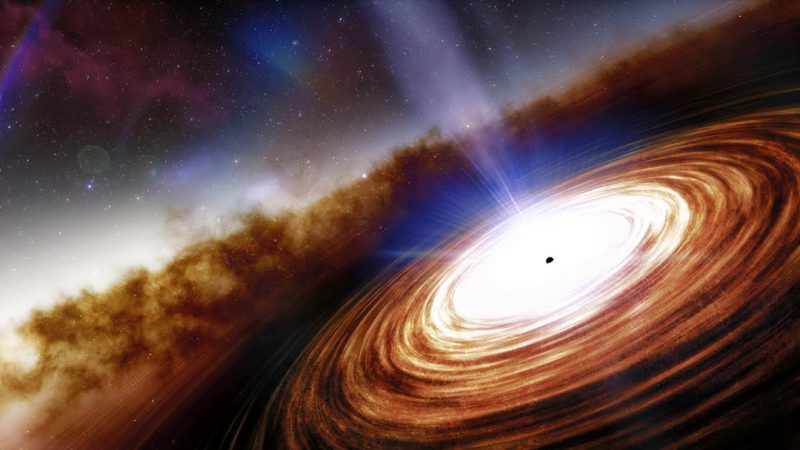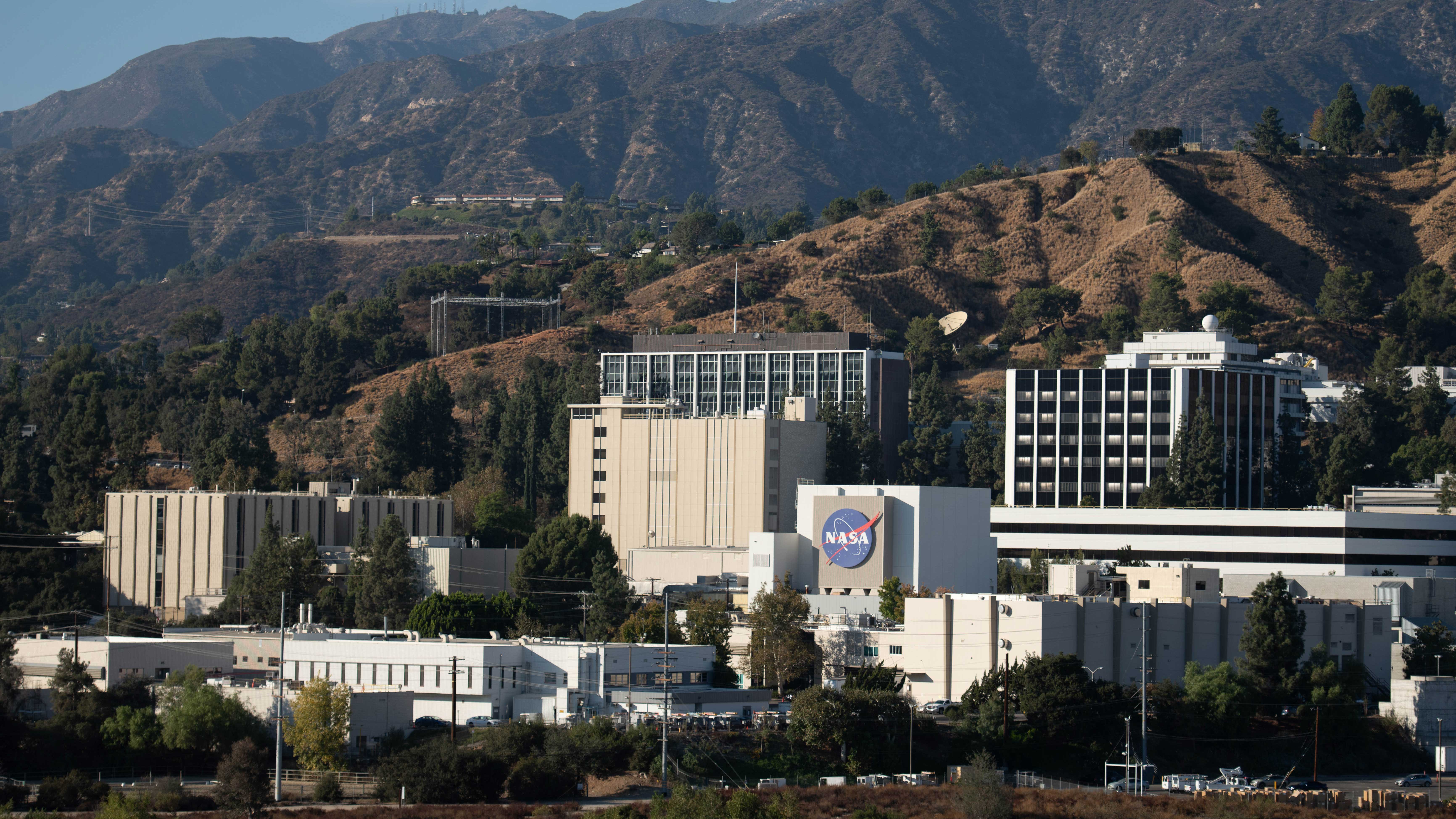Ultraluminous 'hot DOG' galaxy fed by swarm of surrounding satellite galaxies
The ultraluminous galaxy is part of a class called "hot Dust-Obscured Galaxies," or "hot DOGs" for short.

Astronomers have discovered a swarm of galaxies orbiting a distant, ultraluminous galaxy that is forming stars at an intense rate, showing that early galaxies grew in dense environments.
Interactions with these satellite galaxies could be feeding the central galaxy — called W0410-0913 — with gas and stars, thus helping it grow to 10 times the size of the Milky Way. However, these galaxies aren't causing as much chaos in W0410-0913 as scientists previously thought, the researchers found.
The findings could reveal clues as to how bright galaxies can become and how they can come to possess quasistellar radio sources, or quasars, in active galactic nuclei powered by hungry supermassive black holes.
Related: Watch black holes and the stars that feed them dance in this mesmerizing NASA video
As these tremendous cosmic monsters feast on gas, dust and even stars, they blast out a staggering amount of light, often becoming brighter than every star combined in their host galaxy.
W0410-0913 is one of the brightest, most massive, most gas-rich galaxies. Because it takes so long for the light to travel from the galaxy to Earth, we view it as it was 12 billion years ago when the universe was less than 2 billion years old. It is part of a class of galaxies called "hot Dust-Obscured Galaxies," or "hot DOGs" for short.
These galaxies are so named because the large clouds of dust within them are heated by starlight and by energy from the central black hole, causing gas to glow and emit infrared light.
Get the Space.com Newsletter
Breaking space news, the latest updates on rocket launches, skywatching events and more!
The team made the observations of W0410-0913 using the Very Large Telescope (VLT) and the Atacama Large Millimeter/submillimeter Array (ALMA), both operated by the European Southern Observatory (ESO) in Chile.
"Before evolving into a full-blown quasar, some galaxies are thought to go through a phase of being very dusty, and very 'active' in terms of star formation and accretion of gas onto their central, supermassive black holes," team leader and ESO astronomer Michele Ginolfi said in a statement. "We set out to design an experiment to learn more about this transition phase."
Ginolfi and his colleagues didn't just want to study W0410-0913 in isolation, however. Considering how the surroundings of a galaxy can affect its evolution, the team set about studying a region of W0410-0913 that was 40 times as wide as the galaxy itself, using the VLT's Multi Unit Spectroscopic Explorer instrument.
"The observations revealed that W0410-0913 is surrounded by a swarm of no fewer than 24 smaller galaxies," Peter Laursen, a researcher at the Cosmic Dawn Center in Denmark, said in the statement. And these galaxies may be helping to feed gas and stellar material to W0410-0913.

The team's research revealed that W0410-0913 is located in a region of space that's at least 10 times as dense as an average region of the universe. This finding supports previous research showing that hot DOGs exist in dense cosmic environments.
Despite being seen as it was when the universe was less than one-eighth its current age, W0410-0913 has already grown larger than our galaxy, the Milky Way.
For a galaxy to grow to such an enormous size so quickly while also feeding a supermassive black hole, it must have a steady supply of fresh material. Current thinking suggests this material is supplied by the growing galaxy as it pulls in gas, and even smaller satellite galaxies, with its tremendous gravity.
These hot DOG galaxies' superdense environments, which should drive up the rate of galactic interactions, would also assist in this feeding.
A history of violent interactions with other galaxies indicates that W0410-0913 should be a chaotic scene of wildly swirling gas clumps and stars. But the data collected by ALMA regarding the motion of gas in this hot DOG seems to paint a different picture.
Instead, the team found that W0410-0913 didn't seem disturbed by interactions with companion galaxies much at all. Rather, the galaxy's gas rotates in an orderly fashion around its central black hole, albeit at incredibly rapid speeds — up to 1 million mph (1.6 million km/h).
"Nevertheless, despite the expected frequent merging with other galaxies, these gravitational interactions are not necessarily destructive — they feed the central galaxy and whirl up the gas a bit, but leave it practically intact," Ginolfi said in the statement. "A bit like throwing small pebbles against a pane of solid glass: you may scratch it, but won't break it."
The team's observations shed light on the processes behind the evolution of this rare and extreme population of hot dust-obscured galaxies, indicating that the interactions that form them may not always be as chaotic as previously thought.
"Coupling the results from the two very different telescopes, we see a picture of how the most massive and dusty galaxies may evolve," Ginolfi said. "This type of galaxy, a vital stage in the transition from a dusty and star-forming galaxy to a quasar, tends to grow in very dense environments."
The team's research was published Aug. 5 in the journal Nature Communications.
Follow us on Twitter @Spacedotcom and on Facebook.
Join our Space Forums to keep talking space on the latest missions, night sky and more! And if you have a news tip, correction or comment, let us know at: community@space.com.

Robert Lea is a science journalist in the U.K. whose articles have been published in Physics World, New Scientist, Astronomy Magazine, All About Space, Newsweek and ZME Science. He also writes about science communication for Elsevier and the European Journal of Physics. Rob holds a bachelor of science degree in physics and astronomy from the U.K.’s Open University. Follow him on Twitter @sciencef1rst.
